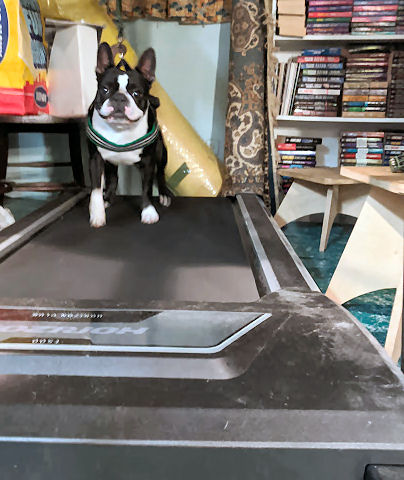When it’s too hot to trot … Dogs need exercise. And one of the best exercises for both dogs and people is walking. (We talked about other kinds of exercise your dog might need in “Wellbeing of dogs.”) But there are times it’s just not practical to go for a long fitness walk. It may be too hot, too cold, too wet, or too icy. You may need to use every walk for training if you have a reactive dog. If, for whatever reason, outdoor walks are impractical, you can train your dog to walk on your treadmill.
There are specifically-designed “dog joggers,” but without a kennel full of dogs that need exercise, the treadmill designed for people works just fine. Especially if you can manually set the speed, incline, and time. That’s what we do with our dogs and they jump on to get started.
Training for treadmill walking
If, like many, your treadmill has become a fancy clothes hanger rather than a routine part of your schedule, the first training step is getting your dog used to the noise the treadmill makes. If you use the treadmill regularly, your dog is already familiar with the sound and shouldn’t fuss about it.
Use high-value treats for all treadmill training. Since this training is for health and fitness, we want the dogs to love it. Set a short program on the treadmill and have your treats handy. Start the treadmill and get your dog into the room on leash and harness. If your dog doesn’t have a harness, get one. It’s a safety issue. The last thing you want is to jerk your dog’s neck if he/she missteps on the treadmill.
For this first step in training the dog isn’t getting on the treadmill, but we want to establish the routine – harness, leash, yummy treats, treadmill. Dogs love routine. Get as close to the treadmill as your dog is comfortable and just reward him/her for being calm. If your dog is wary at first, that’s fine. You’ll move gradually closer as your dog indicates comfort where they are.
If your dog is fine with the sound, let him/her check out the treadmill, looking and sniffing. Keep hold of the leash and try not to allow your dog to step up on the treadmill when it’s moving. It could frighten him/her – things dogs step on don’t usually move by themselves.
Next step
For the next 2-Minute session of treadmill training, leave the treadmill off. This is the session your dog gets to step on the tread, sniff around, and learn the right position for walking on the treadmill. If your treadmill is like ours, there’s a grab bar on the tread side, towards you. Drape the leash over the bar so your dog gets used to seeing it over his/her head.

Think about where you plan to stand and how you’ll deliver rewards when your dog is exercising on the treadmill. Different dogs may require different approaches. Since our dogs are comfortable on our left side through obedience training, we stand to the side of the treadmill, facing the same way as the dog. Remember – always reward with the hand closest to the dog. We hold the leash in our right hands, and deliver treats with the left.
How you do it is up to you and your dog. You can be on the left, right, or even standing over your dog with one foot on either side on the deck. Eventually you may even be able to share the treadmill with your dog. We don’t recommend it, for safety’s sake, but we know some people jog with their dogs. You can also be in front of the treadmill, encouraging your dog to come towards you. Unless you have another person to hold the leash, this isn’t ideal.
Try it, you’ll like it!
After a couple sessions hanging out by the treadmill, both on and off, your dog may be ready to give it a try. Don’t hurry – there’s no rush. If your dog avoids the equipment, he/she isn’t ready to get on it. Don’t ever try to plunk your dog onto the treadmill and start it up. This has to be a voluntary behavior if it has any chance of success.
Set your dog up on the treadmill, wearing his/her harness, leashed and under control. Start the treadmill slowly, without incline, and see how your dog does. You can always increase the speed later. Encourage him/her to walk as it starts up, even “fake-walking” yourself to get the idea across. Reward often and encourage frequently.
If your dog freaks out – go back to sound desensitizing and sniffing/looking sessions. If he/she isn’t frightened, but doesn’t quite know what to do, keep a firm hold of the leash and do not let him/her fall off the back. Encourage with a brisk “Let’s go!” or whatever you say when you go for a walk outside.
Treadmill training
When your dog is comfortable on the treadmill, adjust the program for the time and speed that’s best for you and your dog. Finding your dog’s natural gait speed may take a few tries. Gradually increase speed until your dog is moving comfortably and picking up his/her feet. If you hear nails scraping on the tread, the speed isn’t right for your dog. You can adjust slower as well as faster.
Three or four fitness walks a week are all that’s really necessary to keep your dog in top physical condition. It’s great to have the option of an inside workout when the weather outside is frightful.
